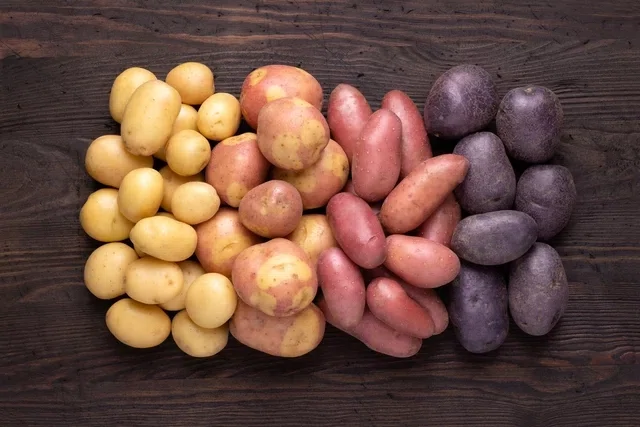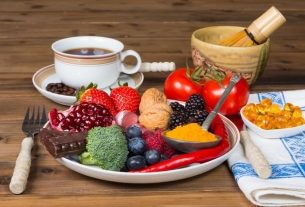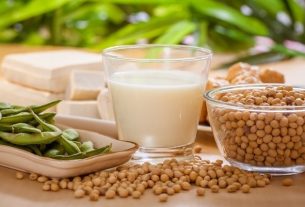The potato, also known as English potato, is a tuber with great amounts of fiber and resistant starch, a type of carbohydrate that acts like fiber in the body, helping to prolong satiety, reducing the desire to eat and promoting weight loss.
As it contains good amounts of polyphenols, flavonoids and anthocyanins, which are compounds with antioxidant and anti-inflammatory properties, this tuber also helps prevent situations such as cancer, diabetes and high blood pressure. See other antioxidants that also help prevent diseases.
There are different types of potatoes, such as smooth, Asterix and polka dots, which vary according to their texture; the color of the pulp, yellow or white; and the color of the shell, which can be white, yellow, pink or purple. Potatoes are usually found in markets and supermarkets and can be used for various preparations, such as mashed potatoes, bread, soup, sautéed potatoes or gratin.
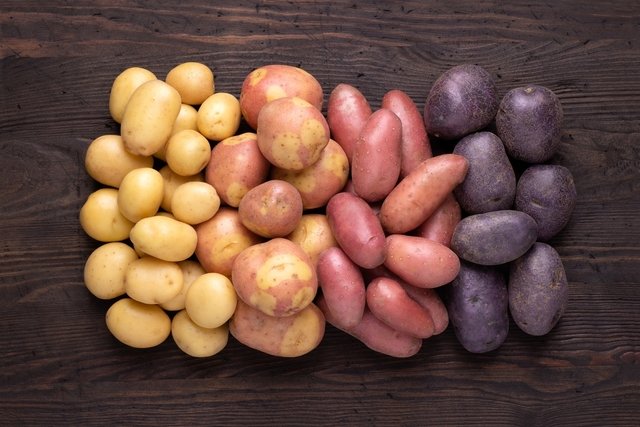
Health benefits of potatoes
The main health benefits obtained from consuming potatoes are:
1. Help with weight loss
Potatoes contain fiber and great amounts of resistant starch, nutrients that help control satiety and reduce the desire to eat between meals, reducing food intake and helping with weight loss.
Furthermore, potatoes also contain fewer calories than other types of tubers, such as sweet potatoes and baroa potatoes. Therefore, including potatoes in your diet can be a good option for weight loss diets.
2. Improve mood
Because it is rich in carbohydrates, potatoes provide energy for the brain, increasing mood. Furthermore, this vegetable can also be a great option for those who practice activities, increasing energy and strength during training. Discover other foods rich in carbohydrates to improve your mood.
3. Control blood pressure
Potatoes are a tuber rich in potassium, a mineral that helps increase urine volume, promoting the elimination of excess sodium from the body and promoting blood pressure control. See how potassium helps control blood pressure.
Furthermore, potatoes, especially those with yellow flesh and skin, contain great amounts of catechins, epicatechin and carotenoids, compounds with antioxidant action that promote the health of arteries, helping to relax blood vessels and, consequently, prevent high pressure.
4. Maintain gut health
Potatoes have excellent amounts of resistant starch, a type of carbohydrate that is not absorbed by the body and that acts as fiber, serving as food for the beneficial bacteria in the intestine, helping to prevent situations such as intestinal infection, diarrhea or constipation.
5. Maintain eye health
Potatoes have excellent amounts of lutein and zeaxanthin, especially in the skin and yellow or orange pulp, which are compounds with antioxidant properties that protect the eyes against free radicals, helping to prevent cataracts and macular degeneration, a disease that decreases vision capacity.
6. Help control diabetes
As it contains good amounts of fiber and resistant starch, potatoes help to reduce the speed at which carbohydrates are absorbed, promoting control of insulin and blood glucose levels, helping to control diabetes.
Like all types of carbohydrates, potatoes can also increase blood sugar levels. Therefore, eat small portions, eat potatoes with the skin and always accompanied by protein, such as eggs or fish; fat, such as olive or avocado oil; and vegetables, such as lettuce and onion, are some tips that help reduce the speed at which potato carbohydrates are absorbed, controlling blood sugar levels.
7. Fight insomnia
Potatoes contain magnesium, B vitamins and tryptophan, nutrients that are responsible for maintaining the nervous system and producing serotonin, promoting relaxation and helping to combat insomnia.
8. Help prevent cancer
Because it contains carotenes and flavonoids, compounds with antioxidant and anti-inflammatory properties, potatoes help prevent cancer, because they combat excess free radicals, the main responsible for damage to healthy cells in the body.
9. Relieve heartburn and poor digestion
Potatoes, especially raw potato juice, are alkaline and have anti-inflammatory and antioxidant effects, neutralizing stomach acidity and helping to relieve burning, pain, heartburn and poor digestion. See how to drink potato juice to relieve heartburn and poor digestion.
10. Strengthen the immune system
Because it contains carotenoids, vitamin C and flavonoids, potatoes help to strengthen immune system cells, protecting the body against situations such as allergies, colds and flu.
Do potatoes make you fat?
Like other types of tubers, potatoes contain high amounts of carbohydrates which, when consumed in excess, can make you fat.
However, potatoes contain excellent amounts of fiber and resistant starch, nutrients that help to prolong satiety and reduce the desire to eat throughout the day. Therefore, moderate potato consumption can be a great option to help with weight loss.
Nutritional information table
The following table contains nutritional information for 140g, corresponding to a medium unit of cooked potatoes with and without skin:
To obtain the benefits of potatoes, it is also essential to maintain a varied and healthy diet, and practice physical exercise regularly.
How to consume
Potatoes can be used raw, in the form of juice, and can also be consumed cooked, roasted or stewed. This tuber can also be used in recipes such as soup, puree, bread, sautéed potatoes and stuffed potatoes.
To enjoy all the benefits of potatoes, it is recommended to consume the skin as well, as it has excellent amounts of fiber, vitamins, minerals and antioxidants. Furthermore, it is important to prioritize healthier forms of preparation, avoiding fried foods, for example.
Tasty potato recipes
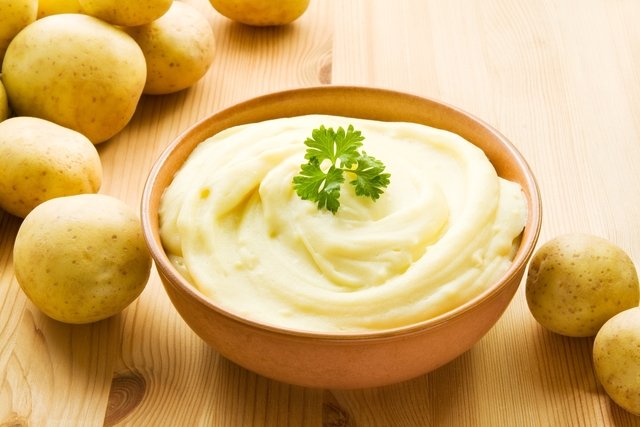
Some tasty and healthy potato recipes include mashed potatoes, sautéed potatoes and stuffed potatoes.
1. Herbed Mashed Potatoes
Ingredients:
- 1 kg of potatoes;
- ¼ cup of olive oil;
- 3 cloves of garlic;
- ¼ cup of coriander leaves;
- ¼ cup of parsley leaves;
- 4 stalks of chives;
- 1 teaspoon of salt;
- Black pepper to taste.
Preparation mode:
Wash well, peel and cut the potatoes into 4 pieces. Place the potatoes in a pan, cover with water and add salt. Boil the potatoes over medium heat until they are very soft. Reserve 1/2 cup of the cooking water and drain the potatoes. Transfer the potatoes to a bowl and mash, while still hot, with a fork. Add the cooking water little by little to the potatoes, mixing with a spoon.
Wash well, drain and chop the coriander, parsley and chives. Peel and chop the garlic. In a pan, add the olive oil and garlic, sautéing for 2 minutes. Turn off the heat and add the chopped herbs, mixing well. Place this stew over the mashed potatoes, mixing well, and serve.
2. Sauteed potatoes
Ingredients:
- 1kg of potato balls (small);
- 2 tablespoons of butter;
- 3 tablespoons of chopped parsley;
- 2 and ½ teaspoons of salt;
- Black pepper to taste.
Preparation mode:
Wash the potatoes well. Place in a pan and cover with water and 2 teaspoons of salt, cooking over medium heat until the potatoes are soft but firm. Drain the potatoes in a colander until they dry well. In a non-stick frying pan, melt the butter, add the potatoes, the remaining salt and pepper, letting it brown for approximately 10 minutes and stirring the potatoes from time to time. Turn off the heat, add the chopped parsley and serve.
3. Potatoes stuffed with vegetables
Ingredients:
- 1 large potato;
- 1 tablespoon of olive oil;
- 2 tablespoons of chopped cooked broccoli;
- 1 tablespoon chopped cooked carrot;
- 1 tablespoon chopped cooked green beans;
- 1 teaspoon of fresh basil;
- Black pepper to taste;
- 3 tablespoons of cottage cheese;
- 1 tablespoon of grated Parmesan cheese;
- 1 pinch of salt.
Preparation mode:
Wash and dry the potato well. Poke holes in the potato with a fork. Place the potato on a plate and cook in the microwave for 15 minutes, turning halfway through. Mix, in a pot, the salt, basil, cottage cheese and black pepper. After cooling, open the potato in half lengthwise and remove some of the pulp with a spoon. Fill the potato with a layer of cottage cream, add the cooked vegetables and finish with another layer of cream. Sprinkle the Parmesan cheese over the potato, cook in the microwave for another 2 or 3 minutes and serve.

Sign up for our newsletter and stay up to date with exclusive news
that can transform your routine!
Warning: Undefined array key "title" in /home/storelat/public_html/wp-content/plugins/link-whisper-premium/templates/frontend/related-posts.php on line 12
Warning: Undefined array key "title_tag" in /home/storelat/public_html/wp-content/plugins/link-whisper-premium/templates/frontend/related-posts.php on line 13

